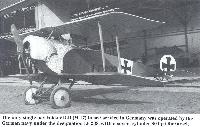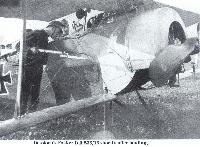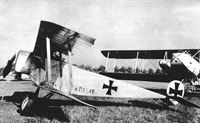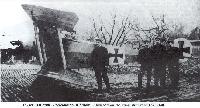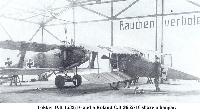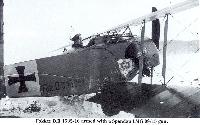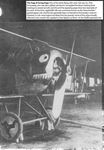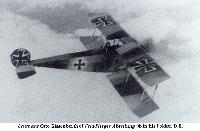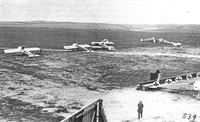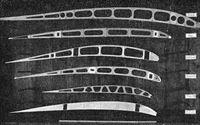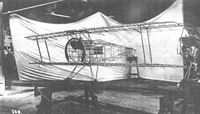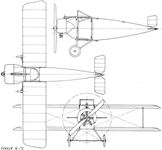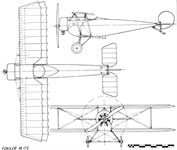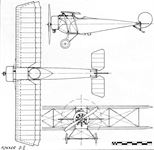
Описание
Страна: Германия
Год: 1916
Истребитель
Варианты
- Fokker - D.II / M.17 - 1916 - Германия
- Fokker - D.III / M.19 - 1916 - Германия
- Fokker - D.V / M.22 - 1916 - Германия
- В.Кондратьев Самолеты первой мировой войны
- A.Weyl Fokker: The Creative Years (Putnam)
- J.Herris, J.Leckscheid Fokker Aircraft of WWI. Vol.3: Early Biplane Fighters (A Centennial Perspective on Great War Airplanes 53)
- J.Herris Fokker Aircraft of WWI. Vol.6: Foreign Service (A Centennial Perspective on Great War Airplanes 56)
- C.Owers Fokker Aircraft of WWI. Vol.7: Postwar (A Centennial Perspective on Great War Airplanes 67)
- O.Thetford, P.Gray German Aircraft of the First World War (Putnam)
- W.Green, G.Swanborough The Complete Book of Fighters
- P.Grosz, G.Haddow, P.Shiemer Austro-Hungarian Army Aircraft of World War One (Flying Machines)
- E.Hauke, W.Schroeder, B.Totschinger Die Flugzeuge der k.u.k. Luftfahrtruppe und Seeflieger 1914-1918
- Журнал Flight
-
J.Herris, J.Leckscheid - Fokker Aircraft of WWI. Vol.3: Early Biplane Fighters /Centennial Perspective/ (53)
Fokker D.II 231/16, Unknown training unit, 1916
-
J.Herris, J.Leckscheid - Fokker Aircraft of WWI. Vol.3: Early Biplane Fighters /Centennial Perspective/ (53)
Fokker D.II 536/16, Ltn. Otto Dessloch, Jasta 16, October 1916
-
В.Кондратьев - Самолеты первой мировой войны
"Фоккер" D.II германских ВВС, 1916г.
-
J.Herris, J.Leckscheid - Fokker Aircraft of WWI. Vol.3: Early Biplane Fighters /Centennial Perspective/ (53)
Fokker D.II 2393/16 Dodo, Kest 4b, Freiburg
-
J.Herris, J.Leckscheid - Fokker Aircraft of WWI. Vol.3: Early Biplane Fighters /Centennial Perspective/ (53)
Fokker D.II 2393/16 Dodo, Kest 4b Freiburg, April 1917
-
J.Herris - Development of German Warplanes in WWI /Centennial Perspective/ (1)
Fokker D.II 540/16 flown by Lt.dR. Otto Kissenberth at KEK (Kampfeinsitzer-Kommando - single-seat fighter detachment) Ensisheim, 12 October 1916. On that day Kissenberth intercepted the famous Oberndorf raid, a combined British and French bombing raid on the German city of Oberndorf, and scored his first three victories in this machine. It has a three-color camouflage scheme that was applied, or at least modified, at KEK Ensisheim. Kissenberth went on to score 20 victories and was awarded the Pour le Merite.
-
J.Herris, J.Leckscheid - Fokker Aircraft of WWI. Vol.3: Early Biplane Fighters /Centennial Perspective/ (53)
Fokker D.II flown by Ltn. Otto Kissenberth of Feld-Flieger Abteilung 9b in late 1916. Serial number unknown.
-
В.Кондратьев - Самолеты первой мировой войны
Фоккер D.II, пилот - лейтенант О.Киссенберг, сентябрь 1916г.
-
J.Herris, J.Leckscheid - Fokker Aircraft of WWI. Vol.3: Early Biplane Fighters /Centennial Perspective/ (53)
Fokker D.II LF238, German Naval Air Service, 1916
-
J.Herris, J.Leckscheid - Fokker Aircraft of WWI. Vol.3: Early Biplane Fighters /Centennial Perspective/ (53)
Fokker D.II, Unidentified FEA
-
J.Herris - Fokker Aircraft of WWI. Vol.6: Foreign Service /Centennial Perspective/ (56)
Fokker M17 03.58, July 1917
-
J.Herris - Fokker Aircraft of WWI. Vol.6: Foreign Service /Centennial Perspective/ (56)
Fokker B.II (M.17) 03.61, Spring 1916
-
J.Herris - Fokker Aircraft of WWI. Vol.6: Foreign Service /Centennial Perspective/ (56)
Fokker B.II (M.17) 03.61, Flik 11, Stanislau
-
J.Herris - Fokker Aircraft of WWI. Vol.6: Foreign Service /Centennial Perspective/ (56)
Fokker B.II (M.17) 03.61, Flars
-
J.Herris - Fokker Aircraft of WWI. Vol.6: Foreign Service /Centennial Perspective/ (56)
Fokker B.II (M.17) 03.61, operated by the Fliegerarsenal (Flars) at Aspern.
-
J.Herris - Fokker Aircraft of WWI. Vol.6: Foreign Service /Centennial Perspective/ (56)
Fokker B.II (M.17) 03.64, Flek 6, Wiener Neustadt, Spring 1918
-
J.Herris - Fokker Aircraft of WWI. Vol.6: Foreign Service /Centennial Perspective/ (56)
Fokker B.II (M.17) 03.77, Flek 8, Spring 1917
-
J.Herris - Fokker Aircraft of WWI. Vol.6: Foreign Service /Centennial Perspective/ (56)
Fokker B.II (M.17) 03.82, Flek 4, Szombathely Aerodrome
-
J.Herris, J.Leckscheid - Fokker Aircraft of WWI. Vol.3: Early Biplane Fighters /Centennial Perspective/ (53)
Fokker B.II 03.82, K.u.k. Fliegertruppe trainer with M.17E airframe, 1916
-
J.Herris, J.Leckscheid - Fokker Aircraft of WWI. Vol.3: Early Biplane Fighters /Centennial Perspective/ (53)
Photo of the diminutive Fokker M.17E single-seat fighter prototype (w/n 433) showing its constrained field of view for the pilot.
-
J.Herris, J.Leckscheid - Fokker Aircraft of WWI. Vol.3: Early Biplane Fighters /Centennial Perspective/ (53)
The single-bay first prototype of the Kreutzer-designed M17 progenitor of the D II
-
J.Herris, J.Leckscheid - Fokker Aircraft of WWI. Vol.3: Early Biplane Fighters /Centennial Perspective/ (53)
The diminutive Fokker M.17E single-seat fighter prototype with Garuda propeller (w/n 433) showing its constrained field of view for the pilot. Photos document that at least three different propellers were tried on this plane. (Peter M. Grosz Collection/STDB)
-
J.Herris, J.Leckscheid - Fokker Aircraft of WWI. Vol.3: Early Biplane Fighters /Centennial Perspective/ (53)
The Fokker M.17E single-seat fighter prototype (w/n 433) photographed at Schwerin in February-March 1916. (Peter M. Grosz Collection/STDB)
-
J.Herris, J.Leckscheid - Fokker Aircraft of WWI. Vol.3: Early Biplane Fighters /Centennial Perspective/ (53)
Fokker in the cockpit of the M.17E. In this photograph the aircraft has a modified undercarriage with double forward legs.
The diminutive Fokker M.17E single-seat fighter prototype (w/n 433) showing its constrained field of view for the pilot. A single gun was fitted and the engine was an 80 hp Oberursel U.0. Roll control was via wing warping. This early design had a rhomboidal rudder, not the comma rudder later common on Fokker designs. (Peter M. Grosz Collection/ STDB) -
J.Herris, J.Leckscheid - Fokker Aircraft of WWI. Vol.3: Early Biplane Fighters /Centennial Perspective/ (53)
Complete line-up of the initial quartet of Fokker's new generation of biplane aircraft in early 1916. Seen from right to left are: M.16 w/n 435, M.16 w/n 418, M.18 w/n 434, and M.17 w/n 433.
Другие самолёты на фотографии: Fokker D.I / M.16 / M.18 - Германия - 1916
-
J.Herris, J.Leckscheid - Fokker Aircraft of WWI. Vol.3: Early Biplane Fighters /Centennial Perspective/ (53)
Fokker fighter prototypes; from left the M.17E, M.16Z, and M.18E. (Peter M. Grosz Collection/STDB)
Другие самолёты на фотографии: Fokker D.I / M.16 / M.18 - Германия - 1916
-
J.Herris, J.Leckscheid - Fokker Aircraft of WWI. Vol.3: Early Biplane Fighters /Centennial Perspective/ (53)
The Fokker fighter prototypes; from left the M.16Z, M.18E, and M.17E.
The small Mercedes-powered M.18E (w/n 434) pictured at centre next to the even more diminutive first M.17E (w/n 433) at right. The fact that sequential works numbers were assigned to both prototypes proves that they were built alongside, as was the earlier-mentioned M.16 prototype w/n 435. The family resemblance of the single-seaters is plainly obvious in this view. (Peter M. Grosz Collection/STDB)Другие самолёты на фотографии: Fokker D.I / M.16 / M.18 - Германия - 1916
-
J.Herris, J.Leckscheid - Fokker Aircraft of WWI. Vol.3: Early Biplane Fighters /Centennial Perspective/ (53)
The Fokker M.17E single-seat fighter prototype (w/n 433) being assembled from its components. The workmen show how small the aircraft is. (Peter M. Grosz Collection/STDB)
-
J.Herris, J.Leckscheid - Fokker Aircraft of WWI. Vol.3: Early Biplane Fighters /Centennial Perspective/ (53)
Fokker's first single-seat biplane fighter prototype, the diminutive first M.17E, is being towed along a wintery Schwerin road, possibly on the way to its first test flight. The plane still lacks armament, and wingspan was so small that the wings could be left in place while the plane was towed from the factory to the airfield and back. (Peter M. Grosz Collection/STDB)
-
J.Herris, J.Leckscheid - Fokker Aircraft of WWI. Vol.3: Early Biplane Fighters /Centennial Perspective/ (53)
Fokker's first single-seat biplane fighter prototype, the diminutive first M.17E, is being towed along a wintery Schwerin road, possibly on the way to its first test flight. The plane still lacks armament, and wingspan was so small that the wings could be left in place while the plane was towed from the factory to the airfield and back. (Peter M. Grosz Collection/STDB)
-
J.Herris, J.Leckscheid - Fokker Aircraft of WWI. Vol.3: Early Biplane Fighters /Centennial Perspective/ (53)
Fokker himself poses next to his latest creation, now with its wings removed and mounted to the brackets on the fuselage side for easier transportation. The aircraft has received an LMG 08 machine gun and a new propeller by now. Judging by the numbers marked on the photos, they were taken around December 1915 or January 1916. (Peter M. Grosz Collection/STDB)
-
J.Herris, J.Leckscheid - Fokker Aircraft of WWI. Vol.3: Early Biplane Fighters /Centennial Perspective/ (53)
Photo of the diminutive Fokker M.17E single-seat fighter prototype (w/n 433) shows it packaged for transportation and being towed. (Peter M. Grosz Collection/STDB)
-
J.Herris, J.Leckscheid - Fokker Aircraft of WWI. Vol.3: Early Biplane Fighters /Centennial Perspective/ (53)
The M.17E (w/n 433) prototype survived the war and is seen here after refurbishment in the Netherlands at the ELTA exhibition in Amsterdam in August/September 1919. It is now fitted with a Le Rhone 9C engine, the crash pylon has been removed, and a larger windscreen has been fitted, but the original rhomboid-shaped rudder has been retained. (Peter M. Grosz Collection/STDB)
-
J.Herris, J.Leckscheid - Fokker Aircraft of WWI. Vol.3: Early Biplane Fighters /Centennial Perspective/ (53)
While the second M.17E was actually assigned the works number 499, it still had to play the role as the 500. aircraft produced by the Fokker company in this commemorative photo. In actual fact, the 500th plane was a Fokker E-type, but obviously the new biplane design was considered as better suited for the purpose. (Peter M. Grosz Collection/STDB)
-
M.Dusing - German Aviation Industry in WWI. Volume 1 /Centennial Perspective/ (84)
Although this M.17E is here represented as the 500th Fokker aeroplane, this is doubtful. Some records indicate that the Factory No. 500 belonged to a Fok. E.II accepted on March 20, 1916. In the group of men, Kreutzer is to the left of the engine, Platz to the right. Next to Platz is de Waal. This M.17E had a 100-h.p. Oberursel.
-
J.Herris, J.Leckscheid - Fokker Aircraft of WWI. Vol.3: Early Biplane Fighters /Centennial Perspective/ (53)
On 12 February 1916, the airfield at Schwerin-Gorries became the site of a special award ceremony. The Grand Duke of Mecklenburg-Schwerin, Friedrich Franz IV, visited the airfield in order to decorate Anthony Fokker with the Mecklenburg-Schwerin Military Merit Cross 2nd Class in honor of his achievements. At 1.84 meters, the Grand Duke was a very tall man for the time, and without a doubt the smiling Anthony Fokker also held a small flight demonstration to celebrate the occasion, as indicated by his flying helmet and the Grand Duke's binoculars. The M.17 (w/n 433) prototype serves as a backdrop for these photos, which were circulated amongst the press. The "Fokker" inscription on the fuselage sides left no doubt as to who was the recipient of the award. (Peter M. Grosz Collection/STDB)
-
J.Herris - Fokker Aircraft of WWI. Vol.6: Foreign Service /Centennial Perspective/ (56)
At Schwerin Anthony Fokker poses with the armed Fokker B.II (M.17) single-bay prototype. The works number is clearly visible on the base of the rhomboid-shaped rudder and the forward lower fuselage, where it was applied just above the lower wing root. In order to demonstrate the lightness of the design, a single man lifts up the pointed tail by the tailskid just with his right hand. When the Austro-Hungarian air service purchased this aircraft and it was delivered in April 1916, it was given serial 03.61. (Peter M. Grosz collection/STDB)
-
J.Herris, J.Leckscheid - Fokker Aircraft of WWI. Vol.3: Early Biplane Fighters /Centennial Perspective/ (53)
After completing the tests at Schwerin, w/n 499 was sent to Austria-Hungary, and here it is shown during evaluation at Aspern. The sharp-pointed tail shows well in this photo, and apparently the new owners have applied a fresh overall coat of white paint to the fabric, covering the works number.
Fokker B.II (M.17) single-bay prototype 03.61 at Aspern. Apart from a Bergmann LMG 15nA machine gun, a complementary armament consisting of a Schwarzlose machine gun was tested in spring 1916. The latter weapon fired above the airscrew, so it was mounted on the framework over the upper wing center-section. The plane had only 80 hp and was not capable of carrying two guns in combat. Therefore, only one of them was retained during its combat deployment on the Front. (Peter M. Grosz collection/STDB) -
J.Herris - Fokker Aircraft of WWI. Vol.6: Foreign Service /Centennial Perspective/ (56)
Fuselage of the prototype Fokker B.II armed with a Schwarzlose M7/12 above the cabane struts and a synchronized Bergmann machine gun at Schwerin before shipment to Austria. (Peter M. Grosz collection/STDB)
-
J.Herris - Fokker Aircraft of WWI. Vol.6: Foreign Service /Centennial Perspective/ (56)
Fokker B.II 03.61 seen with a Schwarzlose non-synchronized machine gun and synchronized Bergmann. In comparison with the German LMG 08 (Maxim) or Bergmann LMG 15nA machine guns, the Schwarzlose had a slower rate of fire and suffered from synchronization problems. Although several Fokker A.III (E.IIIs) had been fitted with the synchronized Schwarzlose machine gun during 1916, most Austro-hungarian single-seaters carried non-synchronized variants of the Schwarzlose on their upper wings until spring 1917. (Peter M. Grosz collection/STDB)
-
J.Herris - Fokker Aircraft of WWI. Vol.6: Foreign Service /Centennial Perspective/ (56)
Fokker B.II (M.17) single-bay prototype 03.61 with Flik 11 for evaluation at Stanislau. This first example of the Fokker B.II of the 03.6 series arrived in Austria in April 1916. It was work number 499. In June 1916 03.61 was deployed experimentally with Flik 11 on the Eastern Front. This photo reveals application of insignia of that period. It consisted of iron crosses on a white background. (Peter M. Grosz collection/STDB)
-
J.Herris - Fokker Aircraft of WWI. Vol.6: Foreign Service /Centennial Perspective/ (56)
Fokker B.II (M.17) 03.61 operated by the Fliegerarsenal (Flars) at Aspern, the plane left for the Front from Aspern and then returned there. The photo was probably taken after its return from the Front. From late 1916 the iron crosses on the wheel discs denoted affiliation to the Fliegerarsenal. Unlike other Fokkers of 03.6 series it retained its original prototype rudder. It also featured a different semi-conical metal cover of an instrument on the fuselage aft of the engine. (Peter M. Grosz collection/STDB)
-
J.Herris - Fokker Aircraft of WWI. Vol.6: Foreign Service /Centennial Perspective/ (56)
Fokker B.II (M.17) 03.61 with Flik 11 at Stanislau airfield. (Peter M. Grosz collection/STDB)
-
J.Herris - Fokker Aircraft of WWI. Vol.6: Foreign Service /Centennial Perspective/ (56)
Fokker B.II (M.17) 03.61 evaluating a synchronized gun mounting with Flik 11 at Stanislau airfield. (Peter M. Grosz collection/STDB)
-
J.Herris - Fokker Aircraft of WWI. Vol.6: Foreign Service /Centennial Perspective/ (56)
Sent to Flik 11 at Stanislau on the Eastern Front in June 1916 for evaluation, the B.II 03.61 was armed with a single Bergmann LMG 15nA machine gun. It was the only series 03.6 aircraft to carry armament. As a trainer, 03.61 was based at Flek 6 in Wiener-Neustadt in October 1918.
Fokker B.II (M.17) 03.61 evaluating a synchronized gun mounting with Flik 11 at Stanislau airfield. -
J.Herris - Fokker Aircraft of WWI. Vol.6: Foreign Service /Centennial Perspective/ (56)
Fokker B.II 03.61 with a synchronized machine gun with Flik 11 at Stanislau, Russian Front. (Peter M. Grosz collection/STDB)
-
J.Herris - Fokker Aircraft of WWI. Vol.6: Foreign Service /Centennial Perspective/ (56)
The castor oil in the exhaust fumes has stained the fabric of this Fokker B.II 03.64 trainer of Flek 6. The characteristic Fokker “button" rudder was standard on production machines.
Well used Fokker B.II 03.64. This trainer served in winter 1917-1918 with Fliegerersatzkompagnie 6 at Wiener Neustadt. Flek 6 was the only unit in the Austro-Hungarian Empire which trained new pilots in single-seat aircraft until spring 1918. That is why the unit was also nicknamed the "Jagdfliegerschule". The typical 'button' Fokker rudder is used and this and later aircraft, not the angular rudder of 03.61, together with wing-warping. -
J.Herris - Fokker Aircraft of WWI. Vol.6: Foreign Service /Centennial Perspective/ (56)
Fokker B.II (M.17) 03.64 sports a primitive experimental gun mounting. (Peter M. Grosz collection/STDB)
-
J.Herris - Fokker Aircraft of WWI. Vol.6: Foreign Service /Centennial Perspective/ (56)
Fokker B.II (M.17) 03.65. (Peter M. Grosz collection/STDB)
-
J.Herris - Fokker Aircraft of WWI. Vol.6: Foreign Service /Centennial Perspective/ (56)
Fokker B.II (M.17) 03.67, work number 761. (Peter M. Grosz collection/STDB)
-
J.Herris - Fokker Aircraft of WWI. Vol.6: Foreign Service /Centennial Perspective/ (56)
Fokker B.II (M.17) 03.67. (Peter M. Grosz collection/STDB)
-
J.Herris - Fokker Aircraft of WWI. Vol.6: Foreign Service /Centennial Perspective/ (56)
Fokker B.II 03.68, work number 766. (Peter M. Grosz collection/STDB)
-
J.Herris - Fokker Aircraft of WWI. Vol.6: Foreign Service /Centennial Perspective/ (56)
Fokker B.II 03.68, work number 766, in flight. (Peter M. Grosz collection/STDB)
-
J.Herris - Fokker Aircraft of WWI. Vol.6: Foreign Service /Centennial Perspective/ (56)
Oberleutnant Leopold Urban poses in front of Fokker B.II 03.68, Flek 6, Wiener Neustadt. The same lucky charm, likely a monkey, appears on the left front strut. Urban served with Flik 16D from autumn 1916 to April 30, 1918 as a pilot of single-seat aircraft. (Peter M. Grosz collection/STDB)
-
J.Herris - Fokker Aircraft of WWI. Vol.6: Foreign Service /Centennial Perspective/ (56)
The 80 hp single-bay production D II.
Flars test pilot Oblt. i.d.Res. Guido Prisel in Fokker B.II 03.68, Flek 6, Wiener Neustadt. Few B.IIs were camouflaged. (Peter M. Grosz collection/STDB) -
J.Herris - Fokker Aircraft of WWI. Vol.6: Foreign Service /Centennial Perspective/ (56)
Fokker B.II 03.77. (Peter M. Grosz collection/STDB)
-
J.Herris - Fokker Aircraft of WWI. Vol.6: Foreign Service /Centennial Perspective/ (56)
Fokker B.II 03.77, work number 773, with Zugsfuhrer Adolf Kind of Flik 21. The photo was taken in spring 1917 at Flek 8. (Peter M. Grosz collection/STDB)
Fokker B.II, "Baby-Fokker", Flugzeugnummer 03.77, Wiener Neustadt, Fliegerersatzkompanie 8, Flugzeugführer Zgsf Adolf Kind
Fokker B.II, "Baby-Fokker", самолет № 03.77, Винер-Нойштадт, рота замены пилотов 8, пилот Zgsf Адольф Кинд -
J.Herris - Fokker Aircraft of WWI. Vol.6: Foreign Service /Centennial Perspective/ (56)
Oberleutnant Fritz Bistrischan in B.II 03.77 performing a very low-level flying display for press photographers in Wiener-Neustadt, 1918.
-
J.Herris - Fokker Aircraft of WWI. Vol.6: Foreign Service /Centennial Perspective/ (56)
Oblt. Fritz Bistritschan puts on a very low-level flying display in Fokker B.II 03.77. (Peter M. Grosz collection/STDB)
-
J.Herris - Fokker Aircraft of WWI. Vol.6: Foreign Service /Centennial Perspective/ (56)
Fokker B.II (M.17) 03.78 with engine removed. (Peter M. Grosz collection/STDB)
-
J.Herris - Fokker Aircraft of WWI. Vol.6: Foreign Service /Centennial Perspective/ (56)
Fokker B.II 03.80, seen probably with one of the Flek units in winter 1916/1917. After the war 03.80 was among the planes left over from the monarchy and taken over by the newly formed Czechoslovakia. However, it was never flown there and was officially written off in March 1920. (Peter M. Grosz collection/STDB)
-
J.Herris - Fokker Aircraft of WWI. Vol.6: Foreign Service /Centennial Perspective/ (56)
Oblt. Colard in Fokker B.II (M.17) 03.81. The wing upper surfaces wear dark camouflage. As the remainder of the upper and lateral surfaces was left unpainted, it is probable that the wings were taken from another Fokker B.II of the 03.6 series. Aircraft 03.81 served with one of the training Fliegerersatzkompagnies (probably Flek 4 at Szombathely or Flek 6 or Flek 8 at Wiener Neustadt). (Peter M. Grosz collection/STDB)
-
J.Herris - Fokker Aircraft of WWI. Vol.6: Foreign Service /Centennial Perspective/ (56)
Hptm. Franz Blicharski, the CO of Flek 4 at Szombathely in Fokker B.II 03.82.
The unarmed Fokker B.II 03.82 fighter-trainer, last machine of the series, with Hauptmann Blischarsky at Flek 4 in Szombathely. -
J.Herris - Fokker Aircraft of WWI. Vol.6: Foreign Service /Centennial Perspective/ (56)
Fokker B.II 03.82 was used by Flek 4 at Szombathely as a trainer. The photo shows the aircraft probably after an overhaul and sporting new fabric. Note that number 03.82 is unusually divided, and there is no cross on the fuselage.
This was one of the 23 M.17E Fokker B.IIs that were purchased by the KuK Luftfahrtruppe for conversion training from two-seater pilots to single-seat fighter pilots. Many of these flew well in to 1918. Two were included in the aircraft purchased by the Czechoslovak Air Force in 1920, but were not flown. Some of the problems w/the lack of castor oil were sought to be resolved by trying other oil types, including corn oil... with bad results. (Peter M. Grosz collection/STDB) -
J.Herris - Fokker Aircraft of WWI. Vol.6: Foreign Service /Centennial Perspective/ (56)
Fokker B.II 03.XX shows its 7 cylinder, 80 hp Oberursel U.O. (Peter M. Grosz collection/STDB)
-
J.Herris - Fokker Aircraft of WWI. Vol.6: Foreign Service /Centennial Perspective/ (56)
A Fokker B.II trainer is the background for this group portrait. Its 7 cylinder, 80 hp Oberursel U.O is prominent. (Peter M. Grosz collection/STDB)
-
J.Herris - Fokker Aircraft of WWI. Vol.6: Foreign Service /Centennial Perspective/ (56)
Two Fokker B.II trainers form the background for this group portrait. (Peter M. Grosz collection/STDB)
-
J.Herris, J.Leckscheid - Fokker Aircraft of WWI. Vol.3: Early Biplane Fighters /Centennial Perspective/ (53)
Naval Fokker D.II LF238 (w/n 803) was the only single-bay Fokker D.II (M.17E) to enter service in Germany; power was provided by an an 80 hp Oberursel U.0; the machine gun is a single LMG 08. It is pictured here in an immaculate finish soon after arrival at its unit.
-
Сайт - Pilots-and-planes /WWW/
Опытный экземпляр "Фоккера" с уменьшенным размахом крыльев и одностоечной бипланной коробкой.
The only single-bay Fokker D.II (M 17) to see service in Germany was operated by the German navy under the designation LF238, with a seven-cylinder 80-hp Oberursel. -
J.Herris - Fokker Aircraft of WWI. Vol.6: Foreign Service /Centennial Perspective/ (56)
Fokker B.II 03.63 (?), work number 761. (Peter M. Grosz collection/STDB)
-
J.Herris, J.Leckscheid - Fokker Aircraft of WWI. Vol.3: Early Biplane Fighters /Centennial Perspective/ (53)
Fokker himself keeps a watchful eye while the fuselage of w/n 499 is covered with fabric. The man on the right has already begun to lace the fabric below the center of the fuselage. On this aircraft, the LMG 08 machinegun was positioned on the left side, the aircraft was powered by a 7-cylinder Oberursel U.0 engine, which was rated at 80 hp. (Peter M. Grosz Collection/STDB)
-
J.Herris, J.Leckscheid - Fokker Aircraft of WWI. Vol.3: Early Biplane Fighters /Centennial Perspective/ (53)
Static testing at the Schwerin factory was carried out with the help of sandbags. Here the wings of the second M.17E (w/n 499) undergo their mandatory test. (Peter M. Grosz Collection/STDB)
-
J.Herris, J.Leckscheid - Fokker Aircraft of WWI. Vol.3: Early Biplane Fighters /Centennial Perspective/ (53)
By comparison, the wings of the initial M.17E (w/n 433) are shown undergoing their inverted weight tests in this photo. Note the smaller wing gap of the first aircraft compared to the upper photo. The small triangular opening below the upper wing, just behind the fuel tank, helps to identify the aircraft. (Peter M. Grosz Collection/STDB)
-
J.Herris, J.Leckscheid - Fokker Aircraft of WWI. Vol.3: Early Biplane Fighters /Centennial Perspective/ (53)
Fokker very much liked to employ his workforce or other human beings in weight tests to visualize the strength of his designs in the best possible way. Here 15 men of the workforce weight test the landing gear of M.17E (w/n 433) - note the flat tire! The fuselage of the Austro-Daimler M.16 (w/n 434) can be seen at right. (Peter M. Grosz Collection/STDB)
Другие самолёты на фотографии: Fokker D.I / M.16 / M.18 - Германия - 1916
-
J.Herris, J.Leckscheid - Fokker Aircraft of WWI. Vol.3: Early Biplane Fighters /Centennial Perspective/ (53)
These photos show the first two-bay version of the M.17, which still had the pointed tail and the rhomboid rudder. Power was now provided by the nine-cylinder Oberursel U.i, which was rated at 100 hp. It is not known if this aircraft was converted to the configuration seen in the next two photos or if these show different aircraft. (Peter M. Grosz Collection/STDB)
-
A.Weyl - Fokker: The Creative Years /Putnam/
The Fokker M.17Z.
-
J.Herris, J.Leckscheid - Fokker Aircraft of WWI. Vol.3: Early Biplane Fighters /Centennial Perspective/ (53)
These photos show the first two-bay version of the M.17, which still had the pointed tail and the rhomboid rudder. Power was now provided by the nine-cylinder Oberursel U.i, which was rated at 100 hp. It is not known if this aircraft was converted to the configuration seen in the next two photos or if these show different aircraft. (Peter M. Grosz Collection/STDB)
-
J.Herris, J.Leckscheid - Fokker Aircraft of WWI. Vol.3: Early Biplane Fighters /Centennial Perspective/ (53)
This photo is thought to show the first - or one of the first - M.17Z two-bay experimental aircraft in flight. Crosses have been applied to the wings and the rudder, which is now of the comma-shaped variant, but not on the fuselage. The machine-gun is now located on the fight side, but the forward landing gear struts do not carry a streamlined covering. (Peter M. Grosz Collection/STDB)
-
J.Herris, J.Leckscheid - Fokker Aircraft of WWI. Vol.3: Early Biplane Fighters /Centennial Perspective/ (53)
The two-bay configuration of the M.17 evolved closer to the production configuration when Oswald Boelcke visited Schwerin to evaluate the latest Fokker designs in late March and early April 1916. The man himself can be seen at the far left of the photo conversing with other visitors. Note the larger cockpit cutout of this prototype, and the LMG 08 is now positioned on the right side. Both features appeared on production aircraft. It also featured a different engine cowling, which was not adopted for production.
-
J.Herris, J.Leckscheid - Fokker Aircraft of WWI. Vol.3: Early Biplane Fighters /Centennial Perspective/ (53)
Static tests of the tailplane of the second two-bay M.17, are shown here. The buckets from which the sand was poured onto the horizontal tail surfaces are left in the picture to better visualize the actual weight of the sand. The machine gun on this plane is offset to the right on this plane. (Peter M. Grosz Collection/STDB)
-
J.Herris, J.Leckscheid - Fokker Aircraft of WWI. Vol.3: Early Biplane Fighters /Centennial Perspective/ (53)
After being cleared for serial production, the M.17 was given the official designation D.II. The first production batch of the new type consisted of a moderate dozen examples carrying the military numbers D 220/16 to 231/16. It is not known if these included the two-bay prototypes, but this was likely the case. Fokker D.II 229/16 was one of the first dozen, and it was delivered to Jagdstaffel 8, which began its operation at Rumbeke airfield in mid-September 1916.
-
J.Herris, J.Leckscheid - Fokker Aircraft of WWI. Vol.3: Early Biplane Fighters /Centennial Perspective/ (53)
This familiar-looking face is that of Vzfw. Walter Gottsch, seated in the cockpit of D.II 229/16. Gottsch joined Jasta 8 as it was starting frontline operations on 15. September 1916, coming from Fliegerabteilung 33. He scored his very first confirmed victory with Jasta 8 on 14. November 1916, when he brought down a Belgian balloon. It is not known if he scored this victory while flying this aircraft. Gottsch remained with Jasta 8 for exactly 17 months and was credited with exactly 17 victories during that time. He was then posted to take command of Jasta Won 14. February 1918, but was killed in the cockpit of a Fokker Dr.I, in April.
-
J.Herris, J.Leckscheid - Fokker Aircraft of WWI. Vol.3: Early Biplane Fighters /Centennial Perspective/ (53)
Perhaps because it was the last aircraft of the initial production batch, Fokker D.II 231/16 was set up for the benefit of the photographer, along with yardsticks. Both 229/16 and 231/16 were delivered in ans all-over plain varnished linen scheme without any kind of camouflage. Note the translucency of the fabric in the bright sunlight, allowing some of the cockpit interior and the upper wing crosses and ribs to shine through the linen.
-
O.Thetford, P.Gray - German Aircraft of the First World War /Putnam/
Fokker D II 231/16.
-
J.Herris, J.Leckscheid - Fokker Aircraft of WWI. Vol.3: Early Biplane Fighters /Centennial Perspective/ (53)
Fokker D.II 526/16 was the fifth aircraft from the second production batch (522/16 - 581/16) and a horizontal stringer is now seen on the fuselage center, which is already well stained. It is thought that this feature was introduced with the first aircraft of the second batch. D.II 526/16 served with Jagdstaffel 25 in Macedonia.
-
D.Mechin - Oriental Adventures of the French Air force 1914-1918 /Aeronaut/
Fokker D.II of the German Air Force photographed at Drama in 1916. (DR)
-
J.Herris, J.Leckscheid - Fokker Aircraft of WWI. Vol.3: Early Biplane Fighters /Centennial Perspective/ (53)
In-flight view of an aircraft operated by Jasta 25 in Macedonia. No traces of a white square background or outline to the Iron Cross marking are visible, indicating that the plain fabric was of a very light, almost white color. No military number can be made out on the fuselage, so it is not clear if this is the same aircraft pictured above.
-
J.Herris, J.Leckscheid - Fokker Aircraft of WWI. Vol.3: Early Biplane Fighters /Centennial Perspective/ (53)
Fokker D.II 533/16 flew with Jasta 12 and is seen here in the early light-colored plain, varnished linen scheme.
-
J.Herris, J.Leckscheid - Fokker Aircraft of WWI. Vol.3: Early Biplane Fighters /Centennial Perspective/ (53)
Fokker D.II 533/16 was delivered to Jasta 12, which began its operations early in October 1916 at the airfield at Vaux. The regular pilot of this D.II was Ltn. Otto Splitgerber, and the honor of being credited with the first confirmed aerial victory on 4 December 1916 fell on him. He brought down an FE 2b from 25. Squadron RFC, but available records do not confirm that he was flying this aircraft on that occasion. (Peter M. Grosz Collection/STDB)
-
J.Herris, J.Leckscheid - Fokker Aircraft of WWI. Vol.3: Early Biplane Fighters /Centennial Perspective/ (53)
The bulged center-section of the upper wing, a common feature on all early Fokker fighters from the D.I to the D.V, can be seen well from this angle. This feature was intended to improve the forward view for the pilot. The aircraft is in plain overall finish, and in the frontal view the Iron Cross markings applied to the upper wings shine through even in the fall sunlight.
-
J.Herris, J.Leckscheid - Fokker Aircraft of WWI. Vol.3: Early Biplane Fighters /Centennial Perspective/ (53)
Another view of 533/16 allows a look at the instrument panel, which can best be described as minimalistic. The rear of the ammunition chute feed shows well in this view, and the rolls over which the wing-warping wires were guided also show to advantage.
-
Сайт - Pilots-and-planes /WWW/
Fokker D.II 536/16 flown by Ltn. Otto Dessloch was forced to land in Switzerland on 13 Oct. 1916. Here a member of the Swiss home guard inspects the aircraft. Dessloch had installed a rear-view mirror on the right side of the cockpit. A Morell Phylax tachometer is fitted to the tip of the port lower wing.
-
J.Herris, J.Leckscheid - Fokker Aircraft of WWI. Vol.3: Early Biplane Fighters /Centennial Perspective/ (53)
Two more photos of Fokker D.II 536/16 flown by Etn. Otto Dessloch after force-landing in Switzerland on 13 Oct. 1916. Dessloch has a biography in The Jasta Pilots and was in command of KEK Ensisheim at the time he was interned in Switzerland, but apparently he somehow escaped or was released back to Germany in January 1917. He was CO of KEK Ensisheim from 2 Jun 1916 to 13 October 1916. Then he was interned in Switzerland until 6 January 1917, when he returned and was posted to FEA 1b. He later served in Jasta 16b and later as CO of Jasta 35.
-
J.Herris, J.Leckscheid - Fokker Aircraft of WWI. Vol.3: Early Biplane Fighters /Centennial Perspective/ (53)
Two more photos of Fokker D.II 536/16 after landing in Switzerland. The photos prove that this aircraft was spray-painted in scheme that was extremely similar to the one applied to 537/16, photos of which can be seen earlier in this chapter. Both aircraft were camouflaged at unit level. In the 1-15 June 1917 issue of the French magazine "L'Aerophile", the colors of a captured Fokker D.II were described as "Green and Brown", and this report is thought to have been based on Dessloch's 536/16. This report was the origin for the previous depiction of the early Fokker factory camouflage scheme in green and brown colors.
-
M.Dusing - German Aviation Industry in WWI. Volume 1 /Centennial Perspective/ (84)
Fok D.II (M17) (1916)
-
J.Herris, J.Leckscheid - Fokker Aircraft of WWI. Vol.3: Early Biplane Fighters /Centennial Perspective/ (53)
Fokker D.II 537/16 serves as a perfect example to illustrate the early application of camouflage at unit level. The aircraft is shown above in factory plain finish at KEK Ensisheim, soon after delivery to the unit, September 1916. Soon after, it received a camouflage very carefully applied by airbrush. This carefully left a light-colored border around the crosses, and it appears the military number was masked before the paint was applied, leaving it mostly intact. Note that the dark wheel covers seen above have been painted in a light color when the lower photo was taken; light blue seems a likely candidate for this unit with its Bavarian background.
-
J.Herris, J.Leckscheid - Fokker Aircraft of WWI. Vol.3: Early Biplane Fighters /Centennial Perspective/ (53)
Two more views of the same aircraft, the upper picture was apparently taken from the hangar roof to allow a look at the new finish from above. In this case, it seems that two colors were applied to Fokker D.II 537/16, but it is impossible to determine which ones were chosen. Dark green, light green, and brown are reported to have been used by the unit for that purpose. The lower photo, possibly taken in November after the unit had been transformed into Jasta 16, shows the plane taking off from Ensisheim.
-
J.Herris - Otto, AGO and BFW Aircraft of WWI /Centennial Perspective/ (37)
An Ago C.I is in the right background with a Fokker D.II in the foreground. (Peter M. Grosz Collection/STDB)
Другие самолёты на фотографии: AGO C.I / C.II - Германия - 1915
-
J.Herris, J.Leckscheid - Fokker Aircraft of WWI. Vol.3: Early Biplane Fighters /Centennial Perspective/ (53)
An Ago C.I seen in the background of this photo invites suggestion that the two aircraft in the photo may have served with Feld-Flieger Abteilung 9b in Colmar, a unit which is known to have operated both types. This unit became Jasta 16b in October 1916. The upper surfaces of the wings, horizontal tailplane, and the fuselage decking of Fokker D.II 540/16 (w/n 832) are painted in the new two-color factory-applied camouflage scheme. This may have been the first D.II to receive this new style of camouflage at Schwerin.
Другие самолёты на фотографии: AGO C.I / C.II - Германия - 1915
-
Сайт - Pilots-and-planes /WWW/
Fokker D.II 540/16
-
J.Herris, J.Leckscheid - Fokker Aircraft of WWI. Vol.3: Early Biplane Fighters /Centennial Perspective/ (53)
Future Pour-le-Merite pilot Josef Jacobs poses next to his new Fokker D.II 541/16 with his mechanics and the ever-faithful German Shepherd's dog. The factory works number 833 can just be discerned on the struts, making identification of the aircraft possible even though the last digit of the military number has already been rendered illegible. Jacobs received this plane in the evening of 19 September 1916, and took it up on a first flight the next day. He did not fly the plane often though, for on the 24th of the month, an oiled up magneto required an engine overhaul, and when it was ready to be flown again on the 29th, he fell ill with dysentery. Jacobs described the plain, un-camouflaged Fokker factory finish of this aircraft as "bright and shiny" and had it re-painted dark blue on the latter date. Due to Jacob's illness, it was then passed on to Oblt. Erich Hoenmanns, who flew it with Jasta 12.
-
J.Herris, J.Leckscheid - Fokker Aircraft of WWI. Vol.3: Early Biplane Fighters /Centennial Perspective/ (53)
Jasta 16b was formed at Ensisheim airfield in mid-October 1916, evolving from KEK Ensisheim. Soon after, several members coming from Feld-Flieger Abteilung 9b also joined the unit. Initial equipment of the Staffel consisted of several Fokker D.IIs, and luckily a number of photographs document these planes. These two pictures show 543/16 (w/n 845) in the winter of 1916/17. The fuselage and tail of this aircraft have received a camouflage scheme applied at unit level with the help of an airbrush. This has covered the fuselage military number and reduced the clear-doped linen square background of the fuselage cross to a narrow pale outline with a somewhat rough border. The rudder has received a full cover of paint, leaving no outline around the cross. Note that the wheels have been mounted inside out, giving better access to the valves. The wheel covers were painted in an unknown color.
-
Сайт - Pilots-and-planes /WWW/
Three-quarter rearview of 543/16. The square backgrounds of the upper wing crosses have also received a coat of dark paint, leaving the crosses with a similar rough white border as the one seen on the fuselage cross.
-
Сайт - Pilots-and-planes /WWW/
Max Holtzem with Fokker D.II 547/16
-
J.Herris, J.Leckscheid - Fokker Aircraft of WWI. Vol.3: Early Biplane Fighters /Centennial Perspective/ (53)
Max Holtzem earned his military flying license before the outbreak of the war, and served with various frontline units and flying schools during the conflict. In this series of photos Max poses with 547/16 at during his service as an instructor at the Bayersiche Militarflieger Schule at Lechfeld, south of Augsburg, in the spring and summer 1917. After a disagreement with the commander of the school, Oberleutnant Richard Euringer, he arranged for his transfer to Bavarian Jagdstaffel 16, where he flew a Fokker D.VII during the last months of the war. The full camouflage pattern applied to the D.II seems to have been the product of frontline ground crew, at least that applied to the fuselage. While doing so, great care has been taken to leave the number on the fuselage intact.
-
J.Herris, J.Leckscheid - Fokker Aircraft of WWI. Vol.3: Early Biplane Fighters /Centennial Perspective/ (53)
Ltn. Eberhard Baier joined Jasta 16b on 31 October 1916, having previously flown with Jasta 15, another Fokker D.II-equipped unit, for just one week. His Fokker D.II 549/16 had its fuselage overpainted in a style very similar to 543/16, but the castor oil spewing from the engine has quickly done its solvent-like job, removing much of the camouflage applied to the lower half of the forward fuselage side. This has caused the military-number to re-emerge. The wheel cover has been painted halved black and white, and the white cross fields on the upper wing have not yet been painted out.
-
J.Herris, J.Leckscheid - Fokker Aircraft of WWI. Vol.3: Early Biplane Fighters /Centennial Perspective/ (53)
The fuel and oil stains along the lower longerons indicate that 554/16 has already been taken up into the air several times. The fuselage sides are left in plain clear-varnished fabric, while the upper surfaces of the wings carry the factory-standard camouflage pattern.
-
J.Herris, J.Leckscheid - Fokker Aircraft of WWI. Vol.3: Early Biplane Fighters /Centennial Perspective/ (53)
Disassembled for transport, D.II 559/16 illustrates the way the lower wings were attached to the mounting posts on the fuselage side. These in turn featured matching mounting points facilitate attachment for transport. The tarpaulin-covered propeller was slung under the fuselage, and at first sight, the bundled-together wing struts below the upper wing center section could be mistaken as a covered machinegun mounted on the left at first sight. The upper wings display the same two-tone camouflage pattern seen on 540/16, while the fuselage sides are still left in plain finish.
The wings stacked against the fuselage sides of D.II 559/16 (W/N 871) for transport allow a good look at the two-tone camouflage pattern applied to the wing upper surfaces. The fuselage sides are left in plain linen fabric, and the fuselage and wing crosses have been applied to a white-painted background. -
J.Herris, J.Leckscheid - Fokker Aircraft of WWI. Vol.3: Early Biplane Fighters /Centennial Perspective/ (53)
Frontal view of D.II 559/16. For transport, the propeller was covered in tarpaulin and slung below the fuselage, fixed to the cross-bracing of the landing gear. The domed shape of the upper wing center-section can be made out well in this view.
-
J.Herris, J.Leckscheid - Fokker Aircraft of WWI. Vol.3: Early Biplane Fighters /Centennial Perspective/ (53)
Fokker D.II 573/16 was probably set up for gun sighting tests when the photo was taken, and two unidentified pilots of an equally unidentified unit seized the opportunity to step into the scene just in time. The aircraft appears to be factory fresh, and the fuselage and wing upper surfaces of this aircraft should be camouflaged in two colors.
-
Сайт - Pilots-and-planes /WWW/
Fokker D.II with Vizefeldwebel R Scholz - numbers on the wing strut read Fok. 1140.
-
В.Кондратьев - Самолеты первой мировой войны
Опытный экземпляр "Фоккера" D.II без вооружения.
-
J.Herris, J.Leckscheid - Fokker Aircraft of WWI. Vol.3: Early Biplane Fighters /Centennial Perspective/ (53)
Carefully set up to be photographed, D.II 1505/16 displays its immaculate uncamouflaged finish. Note the glossy finish of the lower wing surfaces, the translucency of the fabric, which is also noted in other photos, and the stencil gaps in the application of the military number. (Below: Peter M. Grosz Collection/STDB)
-
Сайт - Pilots-and-planes /WWW/
The same aircraft seen in the two previous photos was again photographed soon afterwards, now sporting a freshly-applied two-color camouflage scheme applied to the sides of the fuselage. This picture may have been taken in order to document this new style of camouflage. It already resembles the streaked finish which is so well-known from the Fokker D.Vs and Dr.Is, but the pattern is more opaque than that of most those. The metal nose parts are still left in the turned finish. In numerical sequence, D.II 1505/16 was the 81st D.II manufactured, and it was probably photographed in late October or early November 1916. Note that the fuselage cross has now been applied, and the gaps in the military number on the fuselage sides have been closed.
-
J.Herris, J.Leckscheid - Fokker Aircraft of WWI. Vol.3: Early Biplane Fighters /Centennial Perspective/ (53)
Unarmed Fokker D.II 1512/16 (w/n 896) served with FEA 10 at Boblingen when the photo was taken. It displays the two-color Fokker camouflage on the sides of the fuselage, albeit a very worn version of it. The solvent-like action of the castor-oil fumes passing through the lower rear opening of the engine-cowling have removed much of the lower forward camouflage, and have caused the military number to appear as if it was applied with washed-out watercolor. This aircraft may have seen previous service with Kest 4 at Boblingen.
-
Сайт - Pilots-and-planes /WWW/
Fokker D.II 1533/16 and a Roland C.II 3652/16 share a hangar.
Другие самолёты на фотографии: LFG Roland C.II - Германия - 1915
-
Сайт - Pilots-and-planes /WWW/
Серийный "Фоккер" D.II с синхронным пулеметом LMG 08/15.
Fokker D.II 1535/16 armed with a Spandau LMG 08/15 gun. -
J.Herris, J.Leckscheid - Fokker Aircraft of WWI. Vol.3: Early Biplane Fighters /Centennial Perspective/ (53)
Removal of the metal nose components reveals the welded steel-tube forward section of Fokker D.II 1537/16 (w/n 1025). The pushrods operating the valves of the Gnome-style Oberursel U.I are shown to advantage.
-
J.Herris, J.Leckscheid - Fokker Aircraft of WWI. Vol.3: Early Biplane Fighters /Centennial Perspective/ (53)
Finished in the Fokker two-color factory scheme, D.II 1538/16 ended its service life at a Jastaschule, where it received the number "34".
-
Сайт - Pilots-and-planes /WWW/
Pilot with Fokker D.II 1561/16
-
J.Herris, J.Leckscheid - Fokker Aircraft of WWI. Vol.3: Early Biplane Fighters /Centennial Perspective/ (53)
Armed with an LMG 08/15 and mounting a signal flare storage box within reach of the pilot, 1561/16 seems to have been painted in a two-color camouflage scheme. The forward part, including the engine cowling, received a dark color, possibly dark green, while the rear part may have been light green. The aircraft was shipped to Kest 1, which operated from Mannheim-Sandhofen, on 15 December 1916. The city of Mannheim was subjected to a total of 46 air raids between 1915 and 1918.
-
J.Herris, J.Leckscheid - Fokker Aircraft of WWI. Vol.3: Early Biplane Fighters /Centennial Perspective/ (53)
By contrast to the D.II pictured above, 1569/16 retains the bare metal engine and upper forward fuselage cowling. The camouflage pattern on the wings and rear fuselage appears to have been applied in a dense yet streaky finish. Location and unit are unfortunately not recorded.
-
J.Herris, J.Leckscheid - Fokker Aircraft of WWI. Vol.3: Early Biplane Fighters /Centennial Perspective/ (53)
A late-production example of the Fokker D.II packed up for railway delivery from Schwerin. To ensure safe transport, a framework of wooden post have been mounted to the rear fuselage and the wingtips. In the bottom middle of the photo, the metal lifting handles attached to the bottom longeron of the rear fuselage can be seen, a detail rarely visible in photos of the D.II. This maybe Fokker D.II 1572/16. (Peter M. Grosz Collection/STDB)
A rare case of the lower wing cross having just the narrow white outline is documented by this photo. In most other views, these crosses carried no outline at all or were applied onto white or plain linen square backgrounds. -
J.Herris, J.Leckscheid - Fokker Aircraft of WWI. Vol.3: Early Biplane Fighters /Centennial Perspective/ (53)
Detail photo showing the tailskid and rudder bottom of D.II 1572/16 (w/n 1081) mounted to the wooden tail fixture for rail transport. The aircraft was shipped to Kest 1 on 15 December 1916.
-
J.Herris, J.Leckscheid - Fokker Aircraft of WWI. Vol.3: Early Biplane Fighters /Centennial Perspective/ (53)
A wintry scene at Kest 3 in Karlsruhe, likely in January 1917, with an unidentified pilot and his equally unidentified mechanic posing in front of a factory-fresh aircraft. This is D.II 1579/16, the final aircraft of the penultimate Fokker D.II production batch, and it is armed with an LMG 08. Following the completion of the next batch of 25 aircraft, numbered 2380/16 to 2404/16, production of the type was terminated.
-
J.Herris, J.Leckscheid - Fokker Aircraft of WWI. Vol.3: Early Biplane Fighters /Centennial Perspective/ (53)
D.II 2382/16 was painted in the two-color scheme, which can be easily made out on the fuselage and lower wing. The wheel covers and metal parts were also painted in the darker of the two colors.
-
J.Herris, J.Leckscheid - Fokker Aircraft of WWI. Vol.3: Early Biplane Fighters /Centennial Perspective/ (53)
A smiling pilot in the cockpit of 2386/16 cheerfully shows a gap in his teeth which may have been the result of a previous crash. While this seems somewhat speculative, the unusually thick padding applied to the butt end of the LMG 08/15 machine gun supports this theory. Unit or pilot are not identified.
-
J.Herris, J.Leckscheid - Fokker Aircraft of WWI. Vol.3: Early Biplane Fighters /Centennial Perspective/ (53)
When directly exposed to the sunlight, a camouflage scheme consisting of three different colors, progressively getting darker from the fuselage cross to the engine cowling, becomes apparent. Both photos of D.II 2387/16 were probably taken at the same time. The aircraft is armed with an LMG 08/18, and a rear-view mirror is fitted to the cockpit cutout.
-
J.Herris, J.Leckscheid - Fokker Aircraft of WWI. Vol.3: Early Biplane Fighters /Centennial Perspective/ (53)
Ltn. Wolfgang "Dedi" Pluschow seated in the cockpit of Fokker D.II 2387/16 on a snow-covered airfield, likely in January or February 1917. Pluschow joined Jasta 11 around April of the year, but left the unit again after he was wounded in combat on 7 May. Note the dark appearance of the fuselage in the shadow and the opened valve cover on the inner left wheel cover.
-
J.Herris, J.Leckscheid - Fokker Aircraft of WWI. Vol.3: Early Biplane Fighters /Centennial Perspective/ (53)
Another view of D.II 2387/16, now with dark wheel covers. The propeller may have been one taken from a Fokker D.V, minus the spinner but with the spinner backing plate still in place.The machine gun had been removed by the time this photo was taken.
-
J.Herris, J.Leckscheid - Fokker Aircraft of WWI. Vol.3: Early Biplane Fighters /Centennial Perspective/ (53)
Identical dents and the patch at "one o'clock" position on the engine cowling prove that this is again D.II 2387/16, serving as a backdrop for seven hungry servicemen just before lunchtime. Whether the single duck held by the third man on the left was enough to feed the whole group seems questionable, while the pan held by the man in the centre is woefully undersized. The soldier on the far left appears miraculously unaffected by wartime food shortages.
-
J.Herris, J.Leckscheid - Fokker Aircraft of WWI. Vol.3: Early Biplane Fighters /Centennial Perspective/ (53)
Left: Being one of the last D.IIs to be produced, 2393/16 served with Kest 4b at Freiburg. It was baptized Dodo, the rear fuselage was apparently painted in the colors of the German flag and the rudder was painted in inverted colors. Apparently the "Iron Cross" applied to the wheel cover was the unit marking of Kest 4 in April 1917.
Right: A flying coat lying on the fuselage decking behind the cockpit conveniently obscured both the serial and the name of this Kest 4 D.II. The tail has been painted white, and the rudder is marked in the same inverted style as 2393/16. -
W.Green, G.Swanborough - The Complete Book of Fighters
The two-bay D II of the Fliegertruppen that arrived at the Front during the late summer of 1916.
An unidentified D.II displaying the fuselage camouflage scheme which left cowling in "turned" metal finish. The unit and location are not identified. -
J.Herris, J.Leckscheid - Fokker Aircraft of WWI. Vol.3: Early Biplane Fighters /Centennial Perspective/ (53)
A newly-delivered Fokker D.II of an unidentified unit, possibly serving with a home-defense Kest. Here again the translucency of the lower wing fabric is illustrated perfectly, allowing the upper wing crosses to shine through the glossy fabric applied to the bottom of the wing. Once again, the wheels have been mounted inside out, moving the valve covers to the outside and slightly widening the landing gear track.
-
M.Dusing - German Aviation Industry in WWI. Volume 2 /Centennial Perspective/ (85)
Fokker D.II with Garuda propeller.
-
J.Herris, J.Leckscheid - Fokker Aircraft of WWI. Vol.3: Early Biplane Fighters /Centennial Perspective/ (53)
The style of camouflage applied to the fuselage sides and the nose of this D.II indicates that it may have operated with Jasta 16b. The rough edges of the fuselage and rudder cross are identical to those seen on many Fokker D.IIs flown by that unit. The setting indicates that the photo may have been taken during a visit to a training unit in the winter 1916/17.
-
H.Cowin - Aviation Pioneers /Osprey/
The period between the end of 1915 and the summer of 1917 can be seen as one of the low points in the fortunes of Fokker, the man and his company. This largely fallow time saw Fokker and his designers turn to biplane fighter designs, carrying the military designations D I to D V. As sometimes happens, the second of these, the rotary-powered Fokker D II was to emerge ahead of the in-line engined D I, of which only 25 were produced. Initially appearing at the front in the early spring of 1916, the D II was powered by a 100hp Oberursal U I. Armed with a single 7.92mm Spandau, the D II was woefully lacking in verve and agility, production being switched to the more powerful D III after only 61 examples of the D II had been built.
-
J.Herris, J.Leckscheid - Fokker Aircraft of WWI. Vol.3: Early Biplane Fighters /Centennial Perspective/ (53)
The darkness in the hangar makes it impossible to decipher the military number of this D.II, but the fact that it was present on the camouflaged fuselage indicates that this is a late-production aircraft. It is armed with an LMG 08 and the wheel cover have been removed, exposing the spokes.
-
J.Herris, J.Leckscheid - Fokker Aircraft of WWI. Vol.3: Early Biplane Fighters /Centennial Perspective/ (53)
One of the pilots flying with Jasta 16b was Ltn. Fritz Grunzweig, who was also a gifted caricaturist. He applied the fierce-looking facial markings to several aircraft, and this and the opposing page show two examples of his work. At the time, Jagdstaffel 16b was commonly known as the"Heuschrecken" (grasshopper) unit, and this has generally been connected to Grunzweig's nose art. However, it is far more logical and likely that the popular name of this Jasta actually referred to the overall color applied to their fighters as flown. As the Staffel operated over the Schwarzwald (Black Forrest) region of Germany, it is only logical that the unit-applied camouflage on their Fokker D.IIs consisted of various shades of green, matching the terrain below them. Fritz Grunzweig joined Jasta 16b on 1 November 1916, and initially only stayed with the Jasta until the end of the month. Following a two and a half months stint with FEA 1b, he returned to the unit on 15. February 1917 but was killed in action just two months later on 14 April.
-
Сайт - Pilots-and-planes /WWW/
Fokker D.II with a ‘shark mouth’ painted cowling. The ‘Manx Legs’ on the wheel discs must have looked comical when in motion during take off and landing.
-
J.Herris, J.Leckscheid - Fokker Aircraft of WWI. Vol.3: Early Biplane Fighters /Centennial Perspective/ (53)
An unidentified D.II displaying the fuselage camouflage scheme which left cowling in "turned" metal finish. The unit and location are not identified.
-
J.Herris, J.Leckscheid - Fokker Aircraft of WWI. Vol.3: Early Biplane Fighters /Centennial Perspective/ (53)
Marine enlisted pilot Flugmaat Hahn, nicknamed "Hahnchen" (little rooster) poses in the snow with his Fokker D.II - compare his size to the other photos of pilots posing in front of the D.II! The dark wing leading edges indicate that the wing upper surfaces were camouflaged, while the complete lack of castor oil stains on the lower fuselage and wing roots indicates that this aircraft was new when the photograph was taken. The machine gun blast protection patch is just barely visible on the upper edge of the cowling, and the wheels have already been mounted inside out.
-
J.Herris, J.Leckscheid - Fokker Aircraft of WWI. Vol.3: Early Biplane Fighters /Centennial Perspective/ (53)
Vizefeldwebel Ludwig Hanstein was one of the former members of Feld-Flieger Abteilung 9b to join Jasta 16b, arriving on 31. October. Here he poses in front of a pristine Fokker D.II which has three "running legs" marked on the wheel hubs - compare with the engineless aircraft seen on the left in the earlier "Habsheim" line-up picture. The wheel marking is based on the coat of arms of the city of Fussen located in the eastern Allgau region in Bavaria. Hanstein was later commissioned and went on to command Jasta 35b. He was shot down and killed leading this unit on 21 March 1918 after being credited with 16 victories.
-
J.Herris, J.Leckscheid - Fokker Aircraft of WWI. Vol.3: Early Biplane Fighters /Centennial Perspective/ (53)
The back light in the hangar prevents positive identification of the military number of this D.II, but the camouflaged fuselage, metal turtle deck, and engine cowling indicate that this is a late-production aircraft. It is armed with an LMG 08 and the wheel covers have been removed, exposing the spokes. It possibly served with an unidentified Kest.
-
J.Herris, J.Leckscheid - Fokker Aircraft of WWI. Vol.3: Early Biplane Fighters /Centennial Perspective/ (53)
Seven founding members of Jagdstaffel 15 pictured at Habsheim airfield. The unit was formed on 9 October 1916, and the picture was taken about a week later. Pictured from left to right are: Uffz. Hermann Weingartner, Ltn. Otto Pfaltzer, Ltn. Kurt Haber, Ltn. Friedrich Weitz, Ltn. Helmut Wendel, Vzfw. Herwarth Wendel, and Vzfw. Ernst Udet. With the exception of Ltn. Haber, all men had previously flown with KEK Habsheim. Several of their Fokker D.IIs serve as a backdrop for the photo.
-
J.Herris, J.Leckscheid - Fokker Aircraft of WWI. Vol.3: Early Biplane Fighters /Centennial Perspective/ (53)
Group photo of pilots of Jasta 15 at Habsheim airfield, already covered with small patches of snow, in November 1916. An E.III and two D.IIs serve as the backdrop.
Другие самолёты на фотографии: Fokker E.I / E.II / E.III / M.14 - Германия - 1914
-
J.Herris, J.Leckscheid - Fokker Aircraft of WWI. Vol.3: Early Biplane Fighters /Centennial Perspective/ (53)
Three members of KEK Ensisheim/Jasta 16 with one of their Fokker D.II fighters in October 1916. On this aircraft, the lower wing crosses have received a white outline.
-
J.Herris, J.Leckscheid - Fokker Aircraft of WWI. Vol.3: Early Biplane Fighters /Centennial Perspective/ (53)
It has been well documented that Josef Jacobs fitted captured engines to his Fokker Dr.I in 1918, but he was not the first pilot to do so. Here an uncamouflaged Fokker D.II has been fitted with a captured French 80 hp Le Rhone 9C, which powered the Nieuport 11. Several examples of both types were captured intact by German units, and one wonders if the D.II was re-engined in order to compare the performance of the Fokker to a Nieuport when powered by the same engine.
-
J.Herris, J.Leckscheid - Fokker Aircraft of WWI. Vol.3: Early Biplane Fighters /Centennial Perspective/ (53)
Possibly flying with Flieger-Abteilung 21, Vzfw. Richard Scholz and two members of his ground crew pose in front of a late production D.II. The engine cowling and wings are camouflaged, and the Garuda company logo shows nicely on the propeller. Note that from this angle the big lower rear opening of the engine cowling allows a look at the hangar behind the aircraft.
-
J.Herris, J.Leckscheid - Fokker Aircraft of WWI. Vol.3: Early Biplane Fighters /Centennial Perspective/ (53)
Leutnant zur See Theodor Osterkamp poses in front of a Fokker D.II carrying the naval designation LF 243. The photo was taken at the Naval Aviation Training School at Putzig (Puck) north of Danzig (Gdansk) during March 1917. Osterkamp recalled that the D.II was "a novelty" at Putzig, and he mostly flew the Fokker Eindecker there. Having previously flown inline-engined two-seaters, he had to get accustomed to the vagaries of the Gnome-style rotary engines. Still, he passed his single-seater training within just three weeks. By the end of the war, he was Germany's leading naval ace with a score of 32 confirmed victories and was awarded the Pour le Merite.
-
J.Herris, J.Leckscheid - Fokker Aircraft of WWI. Vol.3: Early Biplane Fighters /Centennial Perspective/ (53)
No doubt taken in order to impress the family back home, Idflieg test pilot Emil Wendler poses in front of an unarmed D.II at Adlershof, while the neatly lined up Fuhrpark of trucks in the background rounds off the picture. The aircraft may well have been used in the experimental application of camouflage schemes. The size and position of the fuselage and rudder cross are not in accordance with Fokker factory practice and indicate that the photo was taken some time in 1917.
-
J.Herris, J.Leckscheid - Fokker Aircraft of WWI. Vol.3: Early Biplane Fighters /Centennial Perspective/ (53)
An unidentified early-production D.II showing the plain fabric fuselage sides, with another pilot standing next to the fuselage obscuring the fuselage military number. The top surfaces of both wings appear to carry a camouflage scheme, which already shows signs of wearing off. Castor oil stains on the forward side fabric indicate that this was a well-used plane.
-
J.Herris, J.Leckscheid - Fokker Aircraft of WWI. Vol.3: Early Biplane Fighters /Centennial Perspective/ (53)
A big rear-view mirror has been fitted to the upper wing cutout of this Kest 4 aircraft at Boblingen. The shadows of both the wing struts and the bracing wires show on the fuselage sides, and the central fuselage stringer show very prominently due to the lighting conditions.
-
J.Herris, J.Leckscheid - Fokker Aircraft of WWI. Vol.3: Early Biplane Fighters /Centennial Perspective/ (53)
A confident-looking Vzfw. Ernst Udet seated in the cockpit of his Fokker D.II, most likely soon after the formation of Jasta 15 in October 1916. Udet is still wearing the crash helmet taken from one of the crew members of his first victory, which he scored on 18. March 1916. His second victory was scored on 12 October, and another 60 would follow over the course of the next two years.
-
J.Herris, J.Leckscheid - Fokker Aircraft of WWI. Vol.3: Early Biplane Fighters /Centennial Perspective/ (53)
This photo supposedly shows Kest 4 pilot OffzStv .Hermann Pohlmann seated in his Fokker D.II, either at Boblingen or Freiburg. What can be seen of the aircraft indicates an immaculate finish; not even the smallest bits of paint have yet chipped off the metal parts. No ammunition was carried when the photo was taken.
-
J.Herris, J.Leckscheid - Fokker Aircraft of WWI. Vol.3: Early Biplane Fighters /Centennial Perspective/ (53)
Mounting an LMG 08 machine gun, this unidentified D.II has been pictured inside a hangar with the pilot in the seat. The low-standing sun projects the shadows of the wing struts onto the fuselage side. For once, the rectangular fuselage access door is shown opened.
-
J.Herris, J.Leckscheid - Fokker Aircraft of WWI. Vol.3: Early Biplane Fighters /Centennial Perspective/ (53)
Few photos show the Fokker D.II from this angle, showing that the wings have been painted in a two-color scheme. The fuselage has been painted in a single color covering the military number. The huge opening at the rear bottom of the cowling allows a look at one of the engine cylinders even from this distance. An vertical appendage of unexplained function has been mounted to the trailing edge of the wing center section.
-
J.Herris, J.Leckscheid - Fokker Aircraft of WWI. Vol.3: Early Biplane Fighters /Centennial Perspective/ (53)
Engine maintenance on the Oberursel U.I engine of the units fighters. The oil stains on the inside wheel cover are rarely seen in photos.
-
J.Herris, J.Leckscheid - Fokker Aircraft of WWI. Vol.3: Early Biplane Fighters /Centennial Perspective/ (53)
That contemporary captions can't always be trusted is proven by these photos. The removed cowling of this Fokker D.II allows a closer look at its 100 hp Oberursel U.I engine, 'Fokker D.D.' translates as "Fokker Biplane". Oddly, it was the Fokker monoplane (E.IV) seen in the background of the photos that was powered by the 160 hp Oberursel U.III instead. The unit and location are unidentified. This D.II was painted in a three-color camouflage scheme.
Другие самолёты на фотографии: Fokker E.IV / M.15 - Германия - 1915
-
J.Herris, J.Leckscheid - Fokker Aircraft of WWI. Vol.3: Early Biplane Fighters /Centennial Perspective/ (53)
An unidentified Bavarian Flieger-Ersatz-Abteilung has carefully refurbished this Fokker D.II, giving it an overall coat of glossy white or light blue paint. This has even been applied to the engine cowling, which can be seen resting below the fuselage. The armament remained in place on this aircraft, which was not always the case with aircraft at an FEA.
-
J.Herris, J.Leckscheid - Fokker Aircraft of WWI. Vol.3: Early Biplane Fighters /Centennial Perspective/ (53)
Next stop: the railway station! A Fokker D.II from the 522/16 - 581/16 batch is being towed to the shipment collection point. The two men seated on the back of the car hold a bundle of struts, and the two-color factory-applied camouflage scheme is evident on both the wings as well as the horizontal tailplane.
This picture provides key identification details that help to determine the likely color of the wing camouflage pattern. The fuselage cross has been applied to the plain fabric without a white background on this aircraft. -
J.Herris, J.Leckscheid - Fokker Aircraft of WWI. Vol.3: Early Biplane Fighters /Centennial Perspective/ (53)
A lion doll has been mounted as a "mascot" to the leading edge of the upper wing, right at the joint of the forward cabane struts. This is another example of a D.II with camouflaged upper wings and plain, unpainted cowling and fuselage sides.
-
J.Herris, J.Leckscheid - Fokker Aircraft of WWI. Vol.3: Early Biplane Fighters /Centennial Perspective/ (53)
The view from below illustrates the massive staining of the forward fuselage bottom and along the central fabric lacing. In contrast to that, the metal chin panel just behind the engine has either been cleaned very thoroughly or freshly painted before this flight.
-
Сайт - Pilots-and-planes /WWW/
Leutnant Otto Kissenberth of Feld-Flieger Abteilung 9b in his Fokker D.II.
-
J.Herris, J.Leckscheid - Fokker Aircraft of WWI. Vol.3: Early Biplane Fighters /Centennial Perspective/ (53)
The in-flight side view proves that the upper wing scheme consisted of three different colors. The uneven edges of the white cross borders are very much in evidence.
-
O.Thetford, P.Gray - German Aircraft of the First World War /Putnam/
Leutnant Otto Kissenberth in his Fokker D.II.
A rare air-to-air photograph of a Fokker D II biplane scout of 1916. -
J.Herris, J.Leckscheid - Fokker Aircraft of WWI. Vol.3: Early Biplane Fighters /Centennial Perspective/ (53)
Exposing the camouflage colors to the sunlight from different angles resulted in different gray scales of the same colors in the various photos of this aircraft.
-
J.Herris, J.Leckscheid - Fokker Aircraft of WWI. Vol.3: Early Biplane Fighters /Centennial Perspective/ (53)
Leutnant Otto Kissenberth from Feld-Flieger Abteilung 9b was liberally photographed over Colmar in the cockpit of his Fokker D.II. This series of photos is thought to have been taken in order to evaluate the effectiveness of the newly-applied camouflage scheme.
-
J.Herris, J.Leckscheid - Fokker Aircraft of WWI. Vol.3: Early Biplane Fighters /Centennial Perspective/ (53)
Judging by what can be seen from the upper wing camouflage scheme, both photos show one and the same D.II from the 522/16 - 581/16 batch in the air. As seen on several aircraft from this batch in earlier photos, the fuselage sides are left in plain linen finish and the bare metal engine cowling is plainly visible. Note the white (or plain linen) squares backing the upper wing crosses. (Peter M. Grosz Collection/STDB)
-
J.Herris, J.Scott - Fokker Aircraft of WWI. Vol.2: Eindeckers /Centennial Perspective/ (52)
The Fokker factory flightline with original annotations by Peter M. Grosz.
Другие самолёты на фотографии: Fokker E.I / E.II / E.III / M.14 - Германия - 1914Fokker E.IV / M.15 - Германия - 1915
-
J.Herris, J.Scott - Fokker Aircraft of WWI. Vol.2: Eindeckers /Centennial Perspective/ (52)
Fokker E.IV 176/16 is seen on the field at Schwerin-Gorries, in between the cellon-covered Fok. E.III 369/16 and a Fok. D.II. This E.IV was delivered from the factory on 31 May 1916 and was on-strength with Abwehrkommando Nord. Max Mulzer was known to have used this aircraft on 2 July during his brief assignment to that unit. (Peter M. Grosz collection/STDB)
Другие самолёты на фотографии: Fokker E.I / E.II / E.III / M.14 - Германия - 1914Fokker E.IV / M.15 - Германия - 1915
-
J.Herris, J.Leckscheid - Fokker Aircraft of WWI. Vol.3: Early Biplane Fighters /Centennial Perspective/ (53)
Taken in early May 1916, this photo captures the assembly of two very early D.I aircraft on the airfield at Schwerin-Gorries. These are most likely 141/16 with its aileron-wings at right, and 140/16 with warping wings next to it, both still lack the military numbers on their fuselages. The aircraft hidden by an M.17 prototype at the left of the picture appears to be another M.18 variation mounting a swept upper wing.
Другие самолёты на фотографии: Fokker D.I / M.16 / M.18 - Германия - 1916
-
J.Herris, J.Leckscheid - Fokker Aircraft of WWI. Vol.3: Early Biplane Fighters /Centennial Perspective/ (53)
Likely the same aircraft photographed at Schwerin in early May along with a Fokker E.III and an M.18 test aircraft, apparently mounting a swept upper wing. This M.17 now featured the comma-shaped rudder and the wider rear fuselage section, which was essentially a reversal to the Fokker E-Type configuration. The military number of this aircraft may have been 607.
Другие самолёты на фотографии: Fokker E.I / E.II / E.III / M.14 - Германия - 1914
-
J.Herris, J.Leckscheid - Fokker Aircraft of WWI. Vol.3: Early Biplane Fighters /Centennial Perspective/ (53)
The motley collection of Jasta 16 at Ensisheim, possibly in November 1916. Seen in the foreground from left are: A D.II, an E.IV, three D.IIs, and an E.III. The two Fokker D.IIs at left already carry the "face" markings seen on some aircraft of the unit.
Другие самолёты на фотографии: Fokker E.I / E.II / E.III / M.14 - Германия - 1914Fokker E.IV / M.15 - Германия - 1915
-
J.Herris, J.Leckscheid - Fokker Aircraft of WWI. Vol.3: Early Biplane Fighters /Centennial Perspective/ (53)
Rare Line-up of eleven Fokker D.II, two Fokker E.III and one E.IV of KEK Habsheim at their airfield, circa September 1916. One of the hangars still carries the "Aviatik" name, the company operated a flying school at Habsheim before it was moved to Leipzig earlier in the year due to its proximity to the front. KEK Habsheim formed the nucleus of Jasta 15 when the Staffel was formed in October.
Другие самолёты на фотографии: Fokker E.I / E.II / E.III / M.14 - Германия - 1914Fokker E.IV / M.15 - Германия - 1915
-
J.Herris, J.Leckscheid - Fokker Aircraft of WWI. Vol.3: Early Biplane Fighters /Centennial Perspective/ (53)
Instructors and student pilots of Geschwaderschule Paderborn gather for a commemorative photo in front of two of their unarmed Fokker D.V trainers, with a D.II taking the central spot.
Другие самолёты на фотографии: Fokker D.V / M.22 - Германия - 1916
-
J.Herris, J.Leckscheid - Fokker Aircraft of WWI. Vol.3: Early Biplane Fighters /Centennial Perspective/ (53)
Fokker D.II at right with a Roland D.II at left. This photo is taken at a unit on the Eastern Front, possibly Galicia, Poland. Fighter aircraft were supplied in twos and threes to the Fliegerabteilungen there. The Roland D.II started replacing the lower-powered Fokkers in the early Spring of 1917.
Другие самолёты на фотографии: LFG Roland D.II - Германия - 1916
-
J.Herris - Roland Aircraft of WWI /Centennial Perspective/ (9)
Roland D.II of Kest 4b shares an airfield with a Fokker D.II in the background.
Другие самолёты на фотографии: LFG Roland D.II - Германия - 1916
-
J.Herris, J.Leckscheid - Fokker Aircraft of WWI. Vol.3: Early Biplane Fighters /Centennial Perspective/ (53)
Fokker D.III 351/16 was sequentially the first production aircraft of the M.19 series. Here the machine is pictured in front of the hangars at the airfield at Schwerin-Gorries, during a dry spell on a rainy day. The machine guns had not yet been installed when the photo was taken. Note the nose of a Fokker D.II the hangar in the background.
Другие самолёты на фотографии: Fokker D.III / M.19 - Германия - 1916
-
J.Herris - Development of German Warplanes in WWI /Centennial Perspective/ (1)
This photo of Kest 4b at Freiburg shows a first-generation Fokker E.IV fighter at left. Second-generation Fokker D.IIs are at the far end of the second row and the two closest fighters in the third row. Two second-generation Fokker D.III fighters are nearest the camera in the middle row. By far the best aircraft in the photo is the Halberstadt fighter furthest from the camera in the third row. The early Fokker biplane fighters were inferior to the Halberstadt and Albatros biplane fighters and were obsolescent on the Western Front. 1917 was a tough year for Fokker, who in January 1917 was directed to build 200 AEG C.IV two-seat trainers instead of his own designs.
Другие самолёты на фотографии: Fokker D.III / M.19 - Германия - 1916Fokker E.IV / M.15 - Германия - 1915Halberstadt D.II/D.III - Германия - 1916
-
J.Herris, J.Leckscheid - Fokker Aircraft of WWI. Vol.3: Early Biplane Fighters /Centennial Perspective/ (53)
When Kampfeinsitzerstaffel (Kest) 4b was formed by dividing Kest 4 into "a" and "b" designated half-units, they moved from Boblingen to Freiburg im Breisgau on 15 April 1917. This group photograph is thought to have been taken to commemorate their arrival at Freiburg, on or soon after this date. Their initial complement of fighters consisted of a somewhat motley collection of types: a Fokker E.IV named Hannah can be seen at far left, the only remaining Eindecker in the unit. The other aircraft seen in the picture are four Fokker D.III, three D.II, and a single Halberstadt, completing the rear trio of aircraft. Note the "Iron Cross" marked wheel hubs, which were possibly the new unit marking for Kest 4b.
Другие самолёты на фотографии: Fokker D.III / M.19 - Германия - 1916Fokker E.IV / M.15 - Германия - 1915Halberstadt D.II/D.III - Германия - 1916
-
J.Herris, J.Leckscheid - Fokker Aircraft of WWI. Vol.3: Early Biplane Fighters /Centennial Perspective/ (53)
A wild mix of Fokker single-seaters is ready to be shipped to the front in mid-August. Photographed behind the Fokker factory at Hintenhof 43 in Schwerin, seen at left in this view area Fokker E.II followed by one D.I and seven Fokker D.II fighters. An engineless E.III, returned to the factory from the front, completes the lineup at left. Note the bright appearance of the D.I and D.II fabric compared to the E.III wing fabric. Seen at right are two D.Is (the second one an LF- marked Naval aircraft), a D.II, another D.I and an E.IV. This is Fokker E.IV 641/15 minus wings. A better view of this plane is available in the next photo.
Другие самолёты на фотографии: Fokker D.I / M.16 / M.18 - Германия - 1916Fokker E.I / E.II / E.III / M.14 - Германия - 1914Fokker E.IV / M.15 - Германия - 1915
-
J.Herris, J.Leckscheid - Fokker Aircraft of WWI. Vol.3: Early Biplane Fighters /Centennial Perspective/ (53)
The same group of aircraft photographed from the other end of the road. Fokker E.IV 641/15, seen at left, was shipped from Schwerin to the front for a second time on 18 August 1916, after being refurbished at the Fokker factory. The battered, engineless E.III is seen at right, note the worn appearance of the upper wing cross. The E.IV and several of the D.Is in these two photos still await their wings to be stacked next to their fuselages for transport.
Другие самолёты на фотографии: Fokker D.I / M.16 / M.18 - Германия - 1916Fokker E.I / E.II / E.III / M.14 - Германия - 1914Fokker E.IV / M.15 - Германия - 1915
-
J.Herris - Fokker Aircraft of WWI. Vol.6: Foreign Service /Centennial Perspective/ (56)
Fokker 03.55 (M 17) coming in for a landing after a training flight. Delivered in September 1916, this machine was written-off in October 1918.
-
J.Herris - Fokker Aircraft of WWI. Vol.6: Foreign Service /Centennial Perspective/ (56)
Unarmed Fokker M.17 03.58 was one of five similar aircraft ordered from Fokker in Germany. 03.58 was Fokker work number 923. At least photo was taken at Flek 7 Parndorf in July, 1917. (Peter M. Grosz collection/STDB)
-
J.Herris - Fokker Aircraft of WWI. Vol.6: Foreign Service /Centennial Perspective/ (56)
Based at Flek 7 in Parndorf in July 1917, Fokker 03.58 (M 17, w/n 923) was flown as an advanced, unarmed single-seat trainer.
-
J.Herris - Fokker Aircraft of WWI. Vol.6: Foreign Service /Centennial Perspective/ (56)
Kpl. Walter Babel at Flek 7, Parndorf, with Fokker M.17 03.58, July 10, 1917. (Peter M. Grosz collection/STDB)
-
A.Weyl - Fokker: The Creative Years /Putnam/
Typical German wing ribs. From top to bottom: A.E.G., Ago, L.T.G., L.F.G., Fok. D.II, and L.V.G.
-
J.Herris, J.Leckscheid - Fokker Aircraft of WWI. Vol.3: Early Biplane Fighters /Centennial Perspective/ (53)
Uncovered early-production Fokker D.V airframe photographed inside Halle 2 of the Fokker factory. In the photo, the fuselage framework of a D.II has sneaked into the right side of the photo. (Peter M. Grosz collection/STDB)
Другие самолёты на фотографии: Fokker D.V / M.22 - Германия - 1916
-
J.Herris, J.Leckscheid - Fokker Aircraft of WWI. Vol.3: Early Biplane Fighters /Centennial Perspective/ (53)
Many helping hands and a horse-driven carriage make the salvage of 577/16 an easier job, a broken landing gear may have been the problem here. The aircraft is unarmed and was probably operated by a training unit in the east. The locally-applied fuselage paint scheme has resulted in a bigger and distorted Iron Cross being marked right behind the cockpit, perhaps in order to insure better identification in the air and from the ground. The airplane number has also been re-marked in a unique way. Four local boys have managed to sneak into the picture at right.
-
J.Herris, J.Leckscheid - Fokker Aircraft of WWI. Vol.3: Early Biplane Fighters /Centennial Perspective/ (53)
Photos documenting nose landings often provide details not seen in many side views. This crash picture of D.II 1576/16 shows that the "R" was not just painted to the upper fuselage sides between cockpit and fuselage cross, but also on the upper wing, slightly offset to the right. A crash pylon has been retro-fitted to the upper wing, but this accident went well without its use. The Naval unit which operated this plane, possibly one of the Zeppelin hangar defense units, had overpainted the square white cross fields with dark (green?) paint.
-
J.Herris, J.Leckscheid - Fokker Aircraft of WWI. Vol.3: Early Biplane Fighters /Centennial Perspective/ (53)
An apparently factory-fresh D.II has been put on its nose by a Vzfw. Hilz, around the time KEK Ensisheim was transformed into Jasta 16b. From this angle the machinegun blast protection plate applied to the cowling can be seen nicely, as is the fuel tank filler cap. The two-color upper camouflage also shows well, while the metal decking behind the cockpit and the engine cowling remain unpainted.
-
J.Herris, J.Leckscheid - Fokker Aircraft of WWI. Vol.3: Early Biplane Fighters /Centennial Perspective/ (53)
The side view of this mishap shows that the fuselage sides and cowling of this plane were left in natural colors, but unfortunately the bright sunlight has rendered the military number illegible. Again, the glossy lower wing fabric is in evidence. Damage to the airframe seems to have been minimal.
-
J.Herris, J.Leckscheid - Fokker Aircraft of WWI. Vol.3: Early Biplane Fighters /Centennial Perspective/ (53)
Any landing that you can walk away from is a good landing! Photographed in December 1916 at Kest 3 in Karlsruhe, a somewhat sheepish looking pilot named Kausch poses for the obligatory post-crash photo following a "Damenlandung". A dark letter "E" possibly red or yellow, has been marked below the cockpit.
-
J.Herris, J.Leckscheid - Fokker Aircraft of WWI. Vol.3: Early Biplane Fighters /Centennial Perspective/ (53)
An unusually heavy landing broke the wheels of this D.II, putting it on its back eventually. Whether the burst port tire was the cause of the accident cannot be determined. It appears that the pilot draped his coat over the bracing wires, indicating that he walked away from the accident.
-
J.Herris, J.Leckscheid - Fokker Aircraft of WWI. Vol.3: Early Biplane Fighters /Centennial Perspective/ (53)
This late-production D.II was crashed by a Kest 3 pilot named Meier at Karlsruhe on 10 March 1917. The steel-tube engine mounting was bent upwards upon impact, pushing the fuel tank upwards, but there was no fire, indicating that the pilot had already switched off the engine before touching down. A white "H" appears to have been marked below the cockpit. An intact D.II is parked in the backgound.
-
J.Herris, J.Leckscheid - Fokker Aircraft of WWI. Vol.3: Early Biplane Fighters /Centennial Perspective/ (53)
Taxpayers' money wasted. The central staging area of the Schwerin-Gorries airfield became something of a morgue for disused Fokker airframes. The fuselages of around 40 Fokker Eindeckers E.III and E.IV and early D-Types are piled up to await disposition in the winter of 1916/17. All engines have been removed. Whenever possible, these were returned to their respective manufacturers or overhaul facilites in order to enjoy a second life in another airframe. Several D.I and D.II aircraft, identified by the upper wing center sections welded to the fuselages, can be seen. Dead center is E.III 222/16.
Другие самолёты на фотографии: Fokker D.I / M.16 / M.18 - Германия - 1916Fokker E.I / E.II / E.III / M.14 - Германия - 1914Fokker E.IV / M.15 - Германия - 1915
-
J.Herris, J.Leckscheid - Fokker Aircraft of WWI. Vol.3: Early Biplane Fighters /Centennial Perspective/ (53)
Having swung slightly to the left, the camera also captured the latest aircraft to be produced by Fokker. Several newly-completed Fokker D.III, perhaps the first to be fitted with ailerons, can be seen at left. The white/plain linen color of the ailerons indicates that these components may have been retro-fitted, possibly because the initial examples failed the mandatory load tests.
Другие самолёты на фотографии: Fokker D.III / M.19 - Германия - 1916
-
J.Herris, J.Leckscheid - Fokker Aircraft of WWI. Vol.3: Early Biplane Fighters /Centennial Perspective/ (53)
Fokker M.17 First Prototype
-
A.Weyl - Fokker: The Creative Years /Putnam/
Fokker M.17E
-
A.Weyl - Fokker: The Creative Years /Putnam/
Fokker M.17E
-
J.Herris, J.Leckscheid - Fokker Aircraft of WWI. Vol.3: Early Biplane Fighters /Centennial Perspective/ (53)
Fokker M.17 Second Prototype
-
J.Herris, J.Leckscheid - Fokker Aircraft of WWI. Vol.3: Early Biplane Fighters /Centennial Perspective/ (53)
Fokker M.17 Final Prototype / D.II
-
W.Green, G.Swanborough - The Complete Book of Fighters
The standard two-bay production D II.
-
A.Weyl - Fokker: The Creative Years /Putnam/
Fokker D.II
-
R.Kosin - The German Fighter since 1915 /Putnam/
Fokker D.II
-
В.Кондратьев - Самолеты первой мировой войны
Fokker D.II/D.III
Другие самолёты на фотографии: Fokker D.III / M.19 - Германия - 1916
-
J.Herris, J.Leckscheid - Fokker Aircraft of WWI. Vol.3: Early Biplane Fighters /Centennial Perspective/ (53)
Fokker D.II flown by Ltn. Otto Kissenberth of Feld-Flieger Abteilung 9b in late 1916. Serial number unknown.
-
P.Grosz, G.Haddow, P.Shiemer - Austro-Hungarian Army Aircraft of World War One /Flying Machines/
Fokker B.II Series 03.6
В.Кондратьев Самолеты первой мировой войны
"ФОККЕР" D.II / FOKKER D.II
Параллельно с созданием истребителя-биплана с двигателем водяного охлаждения на фирме "Фоккер Флюгцойгверк" велись работы по истребителю аналогичной схемы, оснащенному ротативным мотором. Проект под индексом M.19 вел Мартин Кройцер, а после его гибели - новый главный конструктор фирмы Рейнольд Платц.
Прототип M.19 со 100-сильным двигателем "Оберурсель" U.I впервые поднялся в воздух в августе 1916 г. За исключением силовой установки, он был идентичен "Фоккеру" D.I, но летные данные этой более легкой машины оказались выше. В сентябре самолет запустили в серию под индексом D.II, построив 120 экземпляров.
В конце 1916-начале 1917 года машина активно применялась на западном фронте, на ней летали многие известные немецкие асы. Истребитель также выпускался по лицензии венгерской фирмой MAG и поступал на вооружение австро-венгерских ВВС.
МОДИФИКАЦИИ
D.II: двигатель "Оберурсель" UI, 110 л.с., вооружение 1 синхр. LMG 08/15.
ЛЕТНО-ТЕХНИЧЕСКИЕ ХАРАКТЕРИСТИКИ
D.II
Размах, м 8,75
Длина, м 6,29
Сухой вес, кг 425
Взлетный вес, кг 575
Скорость максимальная, км/ч 150
Время подъема на высоту
2000 м, мин.сек 7,00
Потолок, м 4000
Описание:








































































